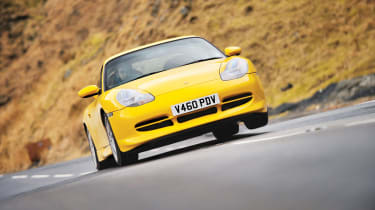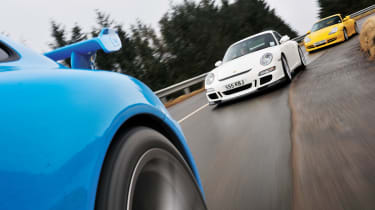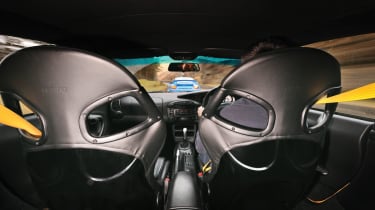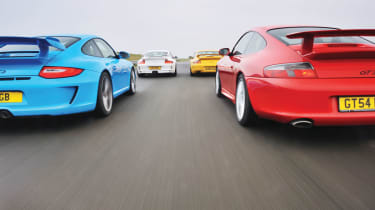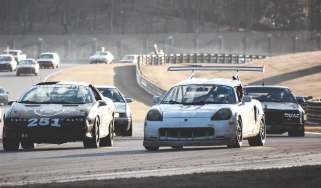Porsche 911 GT3 group test – 996 takes on 997
The GT3 arrived in 1999 in 996 form, and evolved into the 997 eight years later. Which generation of 911 road racer is more exciting today?
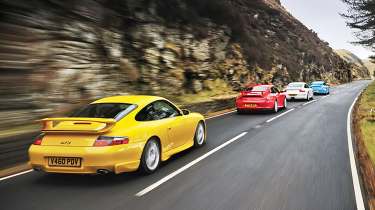
Slowly but surely the flat, red spoiler that’s been jigging, thumping and weaving ahead of me disappears into the distance. A long straight is enough to finish the job started in the many braking zones on the A4061 and continued as each corner opened out and the flat-sixes could zing around to the limiter in second and third. I’m in the original 996 GT3 – in Speed Yellow, of course; the red spoiler belongs to its replacement, and this road has shown that the step from 996 to 997 brought tangible benefits in terms of both speed and outright grip. The white 997 GT3 and Riviera Blue 997 GT3 Gen 2 are long gone, and it’s the 3.8-litre version that’s opened the biggest gap of all despite a damp surface and barely treaded Michelin Cup tyres. It’s probably in another county by now.
So that’s it, then? The GT3 gets fitter, faster and better with every evolution and we might as well all go home? Not quite. The GT3 has never just been about outright power and grip. The joy of this stripped-back 911 is that it mixes purity of purpose with subtlety of feel, chases lap times but never at the expense of driver involvement, and that it rewards at walking pace even though it’s developed to be driven flat-out for hours on end without so much as a flicker of its oil temperature gauge.
So today we’re going to explore the 996 and 997 GT3 in all their iterations, to understand which one delivers the purest hit of that unique 911 driving experience and to consider whether the modern search for ever more speed has eroded the enjoyment for the person sat behind the steering wheel. At a time when the GT3 is offered with PDK, rear-wheel steering (of the electronic kind, not the tyres-on-fire version beloved of this parish) and EPAS, that latter point could be telling. Has the GT3 been gradually heading away from its roots since year zero or just focusing in more tightly? Should we be worried or encouraged by the evolutionary process in the cold light of a British ‘spring’ day? There’s only one way to find out.
More reviews
Group tests
In-depth reviews
Long term tests
Reviews
The 996 GT3 was launched in 1999, and when you first fall down into its distinctive winged seats it feels every single one of its 14 years. Forget that the 996 interior in general is a little bit crummy – in the context of a car that listed a roll-cage amongst its options, that seems wholly irrelevant – it’s the scale of the original GT3 that is almost shocking. It’s tiny. The ’screen is upright, the door trims are thin, the side glass almost seems to press against your right cheek, while your other cheeks skim the road surface. The narrowness, particularly, really gives the 996 the feel of a classic car. So you twist the small, convenient old-fashioned key in the ignition barrel and the 3.6-litre flat-six starts with an initial burst of energy and then clatters and rattles at a grumpy idle. It’s nothing like as loud as the later GT3s with their trick exhaust valves open but I love the unreconstructed trebly thrashing.
With that noise tingling and pulsating through the seat and because you sit so low, this GT3 certainly feels special before it’s even turned a wheel. It gets better though – and you know it will as soon as you slot first and roll away with a little flare of revs. The gearbox itself has a slightly loose action, almost like it’s not really connected to anything mechanical. However, although the other controls share the ’box’s surprisingly light weighting, they feel rigidly connected to the chassis and immediately the car announces its rare precision. There’s not an ounce of play or flab here. For the first few miles you’re in wonderment of the suppleness of the damping and the minimal input and effort required to make the car respond with exacting accuracy. From the outside the 996 GT3 looks so low and so tough, you almost expect a combative driving experience. The reality is less taxing but utterly enthralling: it feels light, alert and incredibly nimble.
In one sense the 996 does drive as it looks – that narrowness is starkly evident by the way you can place it so easily on the road but also because the sheer mechanical grip you expect isn’t really there. There’s little understeer, but the tail always seems to be skipping and slipping and needs constant attention on these bumpy roads. In fast turns you don’t really correct the car but the way it always takes on a little angle really gets and keeps your attention. So it feels incredibly agile, perhaps almost too flighty if you’re not used to 911s, but the way you quickly adapt to its balance and learn to drive it right at the point where it is moving around is a testament to the incredible feel that courses through the entire car. The steering is just delicious, so good that it almost feels like sensory overload at first, and the progression of the chassis, the way the front picks up and the rears dig in on corner exit while the steering wheel jigs and fizzes in your hands, is just so intuitive. Aside from being too easily deflected by mid-corner bumps, the 996 GT3 just feels incredibly simple to drive.
It’s fast, too. I won’t pretend that this original car has the savagery that we’ll discover in the 997s, but the engine is sweet, and beyond 5000rpm this tiny car flies across the ground and deep into three figures with uncomfortable regularity. The combination of 360bhp at 7200rpm, 273lb ft at 5000rpm and 1350kg remains pretty potent. evo's Henry Catchpole has already forgotten that the other GT3s exist: ‘I love the way it rides despite having its wheels tucked up in its arches like a 4.0 RS,’ he begins. ‘I love the delicacy of the steering and I love the organically folded rear wing. I think it might be perfect.’ I leave him stroking the, er, well, let’s just say he needs some time alone.
In 2003 the next chapter of the GT3 story was written. By now Porsche Motorsport had been given a little more freedom and the result was a car with the expected boost in terms of performance but also a number of detail changes: GT3-specific brakes and wheels, wider tyres, an oil cooler and stronger synchros for the gearbox, and more aggressive suspension settings with unique carriers and split rear wishbones for increased camber control. The engine’s displacement remained at 3.6 litres, but in order to achieve higher revs there was a focus on reducing internal weight and friction. Furthermore, the new drive-by-wire system required a huge amount of detail tuning in order to match the throttle response of the original GT3. The result was 375bhp at 7400rpm, 284lb ft at 5000rpm and a rev limit of 8250rpm. Porsche engineers will now admit that the first GT3’s 360bhp was more like 355 and the Gen 2 car’s 375bhp was closer to 390, so despite putting on 30kg we should feel quite a hike in performance terms.
We do. We really, really do. The Gen 2 feels so much faster, and all that work on the drive-by-wire system paid off, because the way the engine responds in the mid-range is frankly astonishing. You’d swear that the motor had grown a few hundred cc thanks to the additional power, but it’s the way it eats through each gear so quickly that really marks it apart. With the original GT3 you look forward to and savour the last 2000rpm or so, with the Gen 2 you just throw gears at it, eyes growing wider with every shift as the frenzy builds in intensity. Within a mile or so you’re smitten.
Somehow I’d expected these two cars to be very similar, separated only by nuance. That isn’t the case at all. The engine is perhaps the most significant progression but there’s so much more. The brakes are vastly better, with a much firmer, more consistent pedal, the gearbox has greater precision, and outright grip has ramped up a significant amount. However, although the car feels faster, angrier and has that sense of invincibility that has come to characterise the GT3, the chassis’ more track-focused nature makes it much more physically demanding to drive quickly on the road. It follows cambers, the front wheels jump and skip over bumps and sometimes it’ll leap half a car’s width to the left or right through roughly surfaced corners. You can certainly make the performance and braking advantage tell, but you’ll be beaten up in the process and have one or two seriously heart-in-mouth moments.
Henry is adamant that his one true love is the better road car. ‘Great engine, but the earlier car is more supple and much more useable. You’re always on the right road in it, but with this sometimes that road never quite materialises and you don’t feel inclined to use the performance.’ I tend to agree, and that’s a real shame as there’s certainly much more traction available and the quality of the controls is top notch. On smoother surfaces it has superb body control, excellent stability and you can lean and lean on the rear tyres with almost reckless abandon. That does bring a little understeer but not enough to ever really slow your pace and I enjoy the challenge of working the weight distribution to unlock the real magic. The bumps will slow you down, though. You’ll either tire of the pummelling or have a fright will rein in your enthusiasm. The 997 GT3 has PASM electronically adjustable dampers – a cause of much consternation when it was launched – and although I adore the Gen 2 996’s aggression and immediacy, I’m beginning to think that to balance road and track performance it was the right move…
Hop from a 2003-spec 996 GT3 to a 2007 997 GT3 and prepare to have your mind blown. Every dynamic element of the package is transformed – power, torque, agility, stability, body control, grip, braking performance… The later car moves the game on to such an extent it beggars belief. We’ve had the sweet, lithe feel of the original car, the more aggressive and focused second generation and now we get the two expertly mixed but with everything turned up to 12, maybe 15.
Again the intensity of the power delivery reaches new heights. Power is up to 409bhp at 7600rpm and torque to 298lb ft at 5500rpm but the performance advantage feels greater than the numbers suggest. Perhaps that’s because the PASM dampers work so well, rediscovering some of the suppleness of the first GT3 and coupling that to a vast increase in grip thanks to the wider tracks, improved suspension design and huge tyres (305/30 ZR19s at the rear). Such is the efficiency of the chassis that you find yourself much more often in the really fiery part of the rev range – a reason to be grateful for the also controversial fitment of traction control. Having said that, even with the TC disabled the 997 covers ground at crazy speed and with real security. So is the driving experience diminished due to the additional grip and control? Not a bit. In fact such is the consistency of control that you edge up to the limits quite readily and then discover a chassis of sublime balance. The key to that is a front end with newfound levels of resistance to understeer combined with the torque to bring those fat rear Michelins into play. Like the original GT3, the tyres’ limits seem to be elastic and the 997 works so well fully hooked up, fully lit or anywhere inbetween. You never seem to run out of options.
The natural balance, then, is quite remarkable. The engine – still 3.6 litres and now producing 113.6bhp per litre – is tractable, fearsomely responsive in the mid-range and feels like a force of nature at the top end. However, the steering feel, the braking performance and the now much heavier, shorter-throw gearbox have all kept pace, allowing you to drive the car really hard without ever really thinking about the process. It sounds mad that a hardcore 911 should be so intuitive but that’s exactly what the 997 GT3 feels like. It inspires confidence. Henry might have a new mistress. ‘Wow. Love the little stuff like the Alcantara for the steering wheel and gearknob,’ he says. ‘But I suppose that pales next to the engine and chassis. So fast, so much control and the damping is superb. Maybe this is the sweet spot.’
And then I plonk myself into the very last Mezger GT3 with a manual gearbox, here with 429bhp from a swept capacity up to 3797cc. It’s utterly, wildly, madly and intoxicatingly brilliant. Like the Gen 2 996 it sacrifices a little suppleness but in its place there’s just more. Take your pick – performance, stability, grip, adjustability, traction… it’s another great leap onwards and upwards. Here’s the key, though: for all the added pace and grip, the 3.8 still challenges and involves, still asks you to bring every bit of skill you’ve got to the driver’s seat and still dances to any tune you want to play. In a world of cynical forum commentators it’s unfashionable to talk about feel and involvement (‘Ha – he said “involvement”, what a pretentious twat’ etc) but I defy anyone to drive this thing and not feel absolutely at the centre of things.
What doesn’t it do well? Not much. There are occasions when it feels a little too stiff compared to the Gen 1, there are plenty more when you wish it had shorter gearing (like the RS version) so you could enjoy the crazed rush to the limiter more readily, and on a warmer, bone-dry day I think it’s fair to say that the masses of grip can prevent you from experiencing its full repertoire at sub-supersonic speeds. Such is the way of things and certainly a 996 GT3 driver will feel like they can exercise their car more easily and less conspicuously (the 3.8 sounds like a Cup car, the flat-six howl audible for miles in Sport mode) at semi-legal speeds (not sure this term is permissible in court). However, the quality of the ceramic brakes is astounding, the steering feel and response is joyous, the way you can disable the stability control to play with the weight distribution but keep the traction control engaged is a stroke of genius. Then there’s the improved control thanks to active engine mounts, which work particularly well on track. It just feels like every detail has been honed with meticulous care and understanding.
It’s snowing, blowing a gale and we’ve been up for what feels like days by the time the camera’s shutter clicks for the last time. This has not been the day, you might think, for track-focused 911s to shine. Yet they have, each car bringing something unique to the GT3 family and each one fully deserved of the iconic status. I’m awed by Porsche’s pace of development as each one feels like a mini-revolution rather than a natural process of evolution.
The original GT3 is as good as we dared to remember, perhaps even better. Its compact dimensions, suppleness and accessible limits make it a perfect match to UK roads. The later 996 is unquestionably faster and it brings a real edge to the GT3 experience. I adore its engine and its physicality. However, the 997s are more exciting. They’re sabre-sharp and just wickedly fast. I know speed isn’t everything but when it’s backed up with such quality it makes for a more thrilling experience. White or blue? Hmm, my sensible head says the more supple Gen 1 but my heart screams 3.8 until it’s fit to burst. Cars don’t come much more intense.
On track
We had hoped to bring a more thorough dissection of these cars on track, complete with lap times and data traces. However, conditions are truly awful when we arrive at the Bedford Autodrome and they’re changing so quickly that any hard data gathered could be misleading. Yet with an empty track at our mercy and four GT3s at our disposal, well, we decide to put in a few laps anyway.
The original GT3 feels pretty much exactly as it does on the road. There’s fine balance and a notable lack of understeer. The limits aren’t sky high and even in damp and greasy conditions it’s amazingly easy to drive quickly. You have to expect plenty of oversteer – especially through the quicker corners – but the car remains driveable and forgiving and it’s a huge amount of fun. The brakes feel a bit weak and grumble very quickly, though.
Once again the 996 Gen 2 shows its performance advantage. The engine is just so sharp and it revs so quickly that you wonder if it’s been fitted with a sprint gearbox. The brakes are also markedly better, resisting fade. However, with considerably more traction and general stability at the rear, it does exhibit more persistent understeer. The trait is exacerbated by the terrible conditions but it makes the car tricky to balance and rather frustrating. We later find that the front anti-roll bar is at its stiffest setting and the rear at its softest, which could be the root of the problem. It’s also a reminder that there’s huge adjustment possible with these cars.
The 997s feel much stiffer structurally and their body control is in a different league. You’d swear the front wheels were six feet further apart such is the turn-in response, and even with a surface glistening with winter crud the traction of both is just stonking. The more supple Gen 1 works brilliantly in these conditions and it feels staggeringly fast even after the frenetic 996 Gen 2. Of course with so much more grip available, the way the tyres lose and regain a hold on the surface is a little sharper and, if you’re not assertive with the throttle, that sensation can make you feel rather clumsy. However, you quickly adapt and find that both of the newer cars respond to confidence rather than tentativeness. Incredibly, it’s the Cup-shod Gen 2 that laps easily the quickest and feels the most secure of all the cars.


